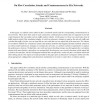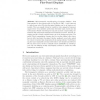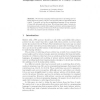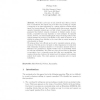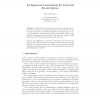115
Voted
PET
2004
Springer
15 years 6 months ago
2004
Springer
In this paper, we address issues related to flow correlation attacks and the corresponding countermeasures in mix networks. Mixes have been used in many anonymous communication s...
85
Voted
PET
2004
Springer
15 years 6 months ago
2004
Springer
90
Voted
PET
2004
Springer
15 years 6 months ago
2004
Springer
Traditional methods for evaluating the amount of anonymity afforded by various Mix configurations have depended on either measuring the size of the set of possible senders of a p...
93
Voted
PET
2004
Springer
15 years 6 months ago
2004
Springer
Electromagnetic eavesdropping of computer displays – first demonstrated to the general public by van Eck in 1985 – is not restricted to cathode-ray tubes. Modern flat-panel d...
86
Voted
PET
2004
Springer
15 years 6 months ago
2004
Springer
113
click to vote
PET
2004
Springer
15 years 6 months ago
2004
Springer
Abstract. We develop a language-based approach for modeling and verifying aspects of privacy policies. Our approach relies on information-flow control. Concretely, we use the prog...
128
click to vote
PET
2004
Springer
15 years 6 months ago
2004
Springer
There are a variety of well-known models for access control developed for purposes like formally modeling the access rights on files, databases, and web resources. However, the ex...
PET
2004
Springer
15 years 6 months ago
2004
Springer
We define a new type of mix network that offers a reduced form of robustness: the mixnet can prove that every message it outputs corresponds to an input submitted by a player wit...
PET
2004
Springer
15 years 6 months ago
2004
Springer
Abstract. Golle et al recently introduced universal re-encryption, defining it as re-encryption by a player who does not know the key used for the original encryption, but which s...
104
Voted
PET
2004
Springer
15 years 6 months ago
2004
Springer
Abstract. In a Ubiquitous Computing environment, sensors are actively collecting data, much of which can be very sensitive. Data will often be streaming at high rates (video and au...
